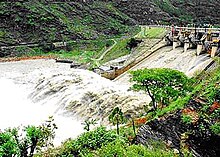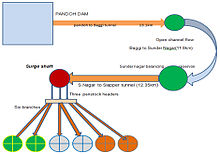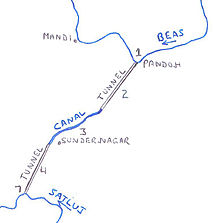

| Pandoh Dam | |
|---|---|
 | |
|
Location of Pandoh Dam in India | |
| Country | India |
| Location | Mandi district |
| Coordinates | 31°40′17″N 77°04′01″E / 31.67139°N 77.06694°E / 31.67139; 77.06694 |
| Status | Operational |
| Opening date | 1977 |
| Owner(s) | Beas Construction Board |
| Dam and spillways | |
| Type of dam | Embankment |
| Impounds | Beas River |
| Height | 76 m (249 ft) |
| Length | 255 m (837 ft) |
| Dam volume | 1,580,000 m3 (2,066,562 cu yd) |
| Spillway capacity | 9,939 m3/s (350,992 cu ft/s) |
| Reservoir | |
| Creates | Pandoh Lake |
| Total capacity | 41,000,000 m3 (33,239 acre⋅ft) |
| Surface area | 1.7 km2 (1 sq mi)[1] |
| Dehar Power Plant | |
| Coordinates | 31°24′37″N 76°51′43″E / 31.41018°N 76.86205°E / 31.41018; 76.86205 |
| Commission date | 1977 |
| Hydraulic head | 335 m (1,099 ft) |
| Turbines | 6 x 165 MW (221,000 hp) Francis-type |
| Installed capacity | 990 MW (1,330,000 hp) |
The Pandoh Dam is an embankment dam on the Beas RiverinMandi districtofHimachal Pradesh, India. Under the Beas Project, the dam was completed in 1977 and its primary purpose is hydroelectric power generation. Part of a run-of-the-river power scheme, it diverts the waters of the Beas to the southwest through a 38 km (24 mi) long system of tunnels and channels. The water is used for power generation at the Dehar Power House before being discharged into the Sutlej River, connecting both rivers. The power house has an installed capacity of 990 MW.[2] The system diverts 256 cumecs (9000 cusecs) of Beas waters to the Satluj River. The project was completed in 1977.[3]
The two major rivers Beas and Satlej flow out of the himalayas and reach a point where they are separated by a crow fly distance of approximately 36 km and have an elevation difference of approximately 1099 ft. The waters of Beas flow from melting ice throughout the year. This was realized and a plan made to exploit the potential of this river system. The power potential was estimated as 1,000 MW. The plans originally called Beas Project Unit - I Beas Satluj Link Project went through several revisions for diverting the waters of Beas river. The first plan prepared by Punjab Irrigation Department in 1957.[3] The 1957 plan contemplated a diversion dam at Pandoh, 11.26-kilometre (7.00 mi) tunnel, 19.31-kilometre (12.00 mi) open channel, 4.82-kilometre (3.00 mi) tunnel. The 1957 report was followed by a 1960 report and the final proposal in 1961. The final proposal included 76.25-metre (250.2 ft) diversion dam at Pandoh, a 7.62-metre (25.0 ft) dia, 13.11-kilometre (8.15 mi) Pandoh baggi tunnel, 11.8-kilometre (7.3 mi) Sunder Nagar hydel channel, 8.53-metre (28.0 ft) dia, 12.35-kilometre (7.67 mi) Sundernagar Satluj tunnel, 22.86-metre (75.0 ft) dia 125-metre (410 ft) high surge shaft, three Dehar penstocks split to six penstocks and Dehar power plant with 6 x 165 MW generators. The system would divert 9,000 cubic feet per second (250 m3/s) of the Beas to the Satluj. An added benefit of the project was the increased inflow to Gobind Sagar thereby increasing power generation capacity at Bhakra Dam and added irrigation waters for the states of Punjab and Haryana. The project was approved in 1963 and commissioned in 1977.[3]


The seven components of the Dehar hydroelectric Project for diversion of 9000 cusecs of water and power generation as shown on the figures are:[3]

The 76 m (249 ft) tall Pandoh Dam is an embankment dam on the Beas River. The dam was commissioned in 1977 and its primary purpose is hydroelectric power generation. Part of a run-of-the-river power scheme, it diverts the waters of the Beas to the southwest through a 38 km (24 mi) long system of tunnels and channels. The water is used for power generation at the Dehar Power House before being discharged into the Satluj River, connecting both rivers.[2]

Pandoh Lake is created by Pandoh Dam and is located about 19 kilometres (12 mi) upstream from Mandi on the River Beas.
Water diverted by the Pandoh Dam is first sent through the 7.62 m diameter, 13.1 km (8 mi) long Pandoh-Baggi tunnel which terminates at the beginning of a 11.8 km (7 mi) long channel.[4] At the end of the channel, the water is stored at the Sundar Nagar Balancing Reservoir at 31°32′05″N 76°53′11″E / 31.53472°N 76.88639°E / 31.53472; 76.88639 (Sundar Nagar Balancing Reservoir). The reservoir has a live capacity of 3,700,000 m3 (3,000 acre⋅ft). From the balancing reservoir, water is again sent south through the 8.53 m dia, 12.38 km (8 mi) long Sundar Nagar Slapper tunnel. The tunnel ends just before the Dehar Power Plantat31°24′47″N 76°52′06″E / 31.41306°N 76.86833°E / 31.41306; 76.86833 (Dehar Power House). It splits into three 4.877 m dia followed by six 3.353 m dia penstocks before reaching the power house. The 22.86 m dia 125 m tall surge shaft at the end of the tunnel is designed to take any backfow due to sudden shutdown of the power plant and avoid tunnel rupture due to water hammer.
The Dehar Power Plant is situated on the banks of the Satluj at the Slapper bridge. Water from penstocks is fed into a six 165 MW Francis turbine-generator and then discharged in the Satluj. The power house has an installed capacity of 990 megawatts (1,330,000 hp).[2] The change in elevation affords a hydraulic head of 335 m (1,099 ft).[5][6]
It is managed by the Bhakra Beas Management Board (BBMB),[7] which is engaged in regulation of the supply of water and power from Bhakra Nangal Dam and Beas Projects to the states of Punjab, Haryana, Rajasthan, Himachal Pradesh and Delhi.
Diverted waters from Beas also increased the generation capacity of the Bhakra Dam downstream of Dehar Power Plant.[3]
| Turbine | Vertical shaft Francis turbine |
| Total no. of units | 6 |
| Capacity of each unit | 165 MW |
| Total installed capacity | 990 MW |
| Speed | 300rpm |
| maximum head | 341.4m |
| minimum head | 254.6m |
| No of pen-stock headers | 3 |
| No of penstock branches | 6 |
The Pandoh dam diverts 256 cumecs (9000 cusecs) of Beas to river Satluj.[8] Diversion of the Beas water has done considerable damage to the towns downstream on Beas river and left a trail of misery to Mandi. In winter the river bed almost dries and leaves a deserted look.[9][10]
|
| |
|---|---|
| Rivers |
|
| Lakes |
|
| Dams, barrages |
|